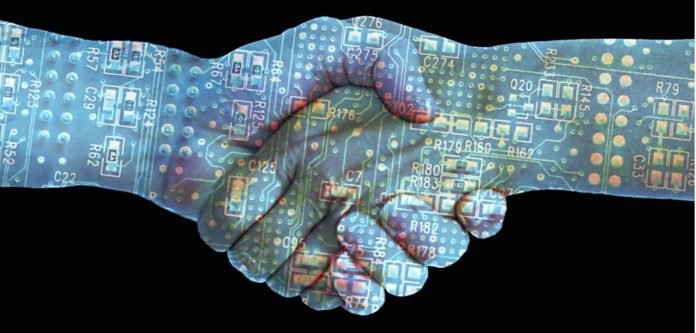Let’s analyse the most critical part of the DLT mechanism: the one in which we enter information from the physical real world onto the blockchain, a decentralized database that could help restore what can be called digital trust.
It is – and has always been – a problem of trust. If humans are involved, why should we trust them?
When we don’t personally know the subjects who perform the action, the only thing we can do is trust them, regardless of whether a paper or digital ledger is used.
However, if we make it so that the data on the blockchain is recorded by a machine (for example, a scale equipped with software suitable for making a transaction directly on the blockchain) it is more acceptable, and could restore – or rather create – digital trust.
Removing the physical paperwork that often is full of errors, means removing humans from the process and making it faster and at a lower cost.
Therefore, adapters must be implemented allowing the sensors to interface directly with the blockchain.
Similarly to the water meter, it is better not to trust humans because they have all the incentive to change the data to their advantage. Putting the seals on and enabling automatic reading of the counter does not eliminate the risk, but significantly reduces it.
This is a very important point: on everything that is done before the introduction of the data, the blockchain has no role.
The blockchain is a dividing line of trust: before introducing the data, there’s only human trust; after introducing the data, trust is encoded in the mathematical proof.
The data written on the blockchain is not always true.
What is true is who wrote it, what they added and when it was entered. It is the consensus of the majority of honest nodes to decide what is considered valid. Somewhat similar to the mechanism of publication used by Wikipedia.
This is certainly a concept that needs to be studied more. A necessary but not sufficient condition is the notarization (Proof of Presence) – in a trustless way – of the existence of the good at a given moment.
But if the property has to be certified on the blockchain by a subject, it is necessary to use a Proof of Publication, ensuring that double spending doesn’t occur.
The owner of the information, in addition to being sure of the company that produced the luxury handbag for example, can also be sure of being the sole owner of the item. All these “proofs of” are actually inviolable mathematical evidence of the fact that the task has been completed. It can now be easily verified by anyone since it is permanently recorded on the blockchain.
The data notarized on the blockchain provide a timestamp, a kind of digital wax that makes manipulation impossible. So it is easy for the counterparts, both human and mechanical, to verify the correctness of the data. But beware: this does not imply the truthfulness of the data.
The ideal setup is to have cheap and low power consumption sensors connected directly to the blockchain. The tag on the product can indicate the different public addresses corresponding to the various operators with whom it came into contact.
These operators, being the only owners of the private key with which to sign each movement of the asset, take responsibility in the context of an unalterable blockchain.
In other words, once the object is registered, for example a luxury handbag, with an identifier that corresponds to a transaction on the blockchain, there cannot be two same handbags in the real world. The problem of double spending is naturally solved thanks to the blockchain.
We have seen that sensors and machines can insert data on the blockchain, but it is humans who have the task of verifying it.
This has extreme consequences, in the sense that we cannot change the physical world. Once it is digitalized and we have given the supremacy of governance, we should no longer have options to intervene. Let’s think about payments, for example: once tokens are linked to smart contracts, they run autonomously without human discretion.
A first summary
Three tools are available:
– Trust in operators (to be given only where necessary)
– Blockchain technology (which does not allow the modification of the data after entering it. Namely notarization)
– Tracing back more easily and quickly who did what and when in the event of a breach (so as to allow the supervisory bodies to do a verification).



